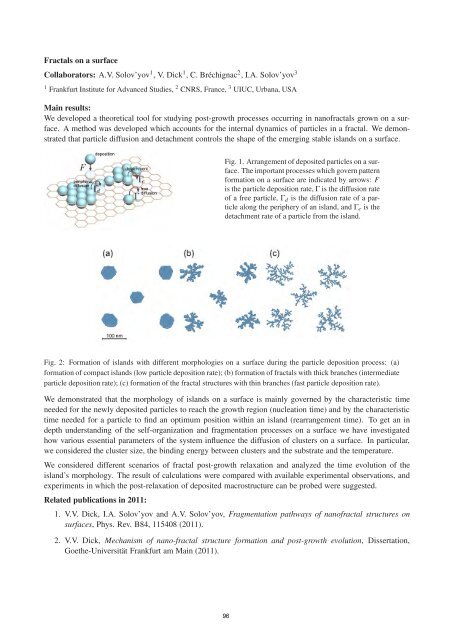FIAS Scientific Report 2011 - Frankfurt Institute for Advanced Studies ...
FIAS Scientific Report 2011 - Frankfurt Institute for Advanced Studies ...
FIAS Scientific Report 2011 - Frankfurt Institute for Advanced Studies ...
You also want an ePaper? Increase the reach of your titles
YUMPU automatically turns print PDFs into web optimized ePapers that Google loves.
Fractals on a surface<br />
Collaborators: A.V. Solov’yov 1 , V. Dick 1 , C. Bréchignac 2 , I.A. Solov’yov 3<br />
1 <strong>Frankfurt</strong> <strong>Institute</strong> <strong>for</strong> <strong>Advanced</strong> <strong>Studies</strong>, 2 CNRS, France, 3 UIUC, Urbana, USA<br />
Main results:<br />
We developed a theoretical tool <strong>for</strong> studying post-growth processes occurring in nanofractals grown on a surface.<br />
A method was developed which accounts <strong>for</strong> the internal dynamics of particles in a fractal. We demonstrated<br />
that particle diffusion and detachment controls the shape of the emerging stable islands on a surface.<br />
Fig. 1. Arrangement of deposited particles on a surface.<br />
The important processes which govern pattern<br />
<strong>for</strong>mation on a surface are indicated by arrows: F<br />
is the particle deposition rate, Γ is the diffusion rate<br />
of a free particle, Γd is the diffusion rate of a particle<br />
along the periphery of an island, and Γe is the<br />
detachment rate of a particle from the island.<br />
Fig. 2: Formation of islands with different morphologies on a surface during the particle deposition process: (a)<br />
<strong>for</strong>mation of compact islands (low particle deposition rate); (b) <strong>for</strong>mation of fractals with thick branches (intermediate<br />
particle deposition rate); (c) <strong>for</strong>mation of the fractal structures with thin branches (fast particle deposition rate).<br />
We demonstrated that the morphology of islands on a surface is mainly governed by the characteristic time<br />
needed <strong>for</strong> the newly deposited particles to reach the growth region (nucleation time) and by the characteristic<br />
time needed <strong>for</strong> a particle to find an optimum position within an island (rearrangement time). To get an in<br />
depth understanding of the self-organization and fragmentation processes on a surface we have investigated<br />
how various essential parameters of the system influence the diffusion of clusters on a surface. In particular,<br />
we considered the cluster size, the binding energy between clusters and the substrate and the temperature.<br />
We considered different scenarios of fractal post-growth relaxation and analyzed the time evolution of the<br />
island’s morphology. The result of calculations were compared with available experimental observations, and<br />
experiments in which the post-relaxation of deposited macrostructure can be probed were suggested.<br />
Related publications in <strong>2011</strong>:<br />
1. V.V. Dick, I.A. Solov’yov and A.V. Solov’yov, Fragmentation pathways of nanofractal structures on<br />
surfaces, Phys. Rev. B84, 115408 (<strong>2011</strong>).<br />
2. V.V. Dick, Mechanism of nano-fractal structure <strong>for</strong>mation and post-growth evolution, Dissertation,<br />
Goethe-Universität <strong>Frankfurt</strong> am Main (<strong>2011</strong>).<br />
96
















